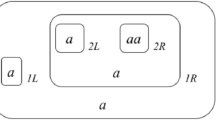Abstract
This paper aims to answer the following question: given a P system configuration M, how do we find each configuration N such that N evolves to M in one step? While easy to state, the problem has not a simple answer. To provide a solution to this problem for a general class of P systems with simple communication rules and without dissolution, we introduce the dual P systems. Essentially these systems reverse the rules of the initial P system and find N by applying reversely valid multisets of rules. We prove that in this way we find exactly those configurations N which evolve to M in one step.
Preview
Unable to display preview. Download preview PDF.
Similar content being viewed by others
References
Barretta, C., Hunt III, H.B., Marathea, M.V., Ravic, S.S., Rosenkrantz, D.J., Stearns, R.E., Thakurd, M.: Predecessor existence problems for finite discrete dynamical systems. Theoretical Computer Sci. 386, 3–37 (2007)
Leporati, A., Zandron, C., Mauri, G.: Reversible P systems to simulate Fredkin circuits. Fundamenta Informaticae 74, 529–548 (2006)
Morita, K.: Reversible computing and cellular automata – A survey. Theoretical Computer Sci. 395, 101–131 (2008)
Păun, G.: Membrane Computing. An Introduction. Springer, Heidelberg (2002)
Author information
Authors and Affiliations
Editor information
Editors and Affiliations
Rights and permissions
Copyright information
© 2009 Springer-Verlag Berlin Heidelberg
About this paper
Cite this paper
Agrigoroaiei, O., Ciobanu, G. (2009). Dual P Systems. In: Corne, D.W., Frisco, P., Păun, G., Rozenberg, G., Salomaa, A. (eds) Membrane Computing. WMC 2008. Lecture Notes in Computer Science, vol 5391. Springer, Berlin, Heidelberg. https://doi.org/10.1007/978-3-540-95885-7_7
Download citation
DOI: https://doi.org/10.1007/978-3-540-95885-7_7
Publisher Name: Springer, Berlin, Heidelberg
Print ISBN: 978-3-540-95884-0
Online ISBN: 978-3-540-95885-7
eBook Packages: Computer ScienceComputer Science (R0)




